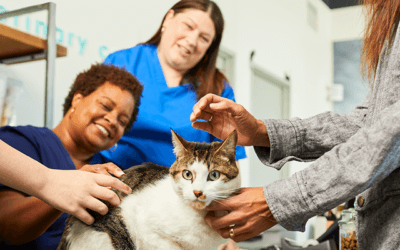How often do you use the F-word at your practice?
I mean “feedback”… of course!
For some veterinary teams, asking for and receiving feedback might truly be “taboo” — something that’s avoided whenever possible and panic-inducing when it can’t be avoided. But when the F-word has a regular place in our vocabulary, it stops becoming a source of anxiety and starts becoming a source of inspiration and positive change.
Read on for a comprehensive look at asking for, receiving, and giving feedback in your veterinary practice.
What is feedback?
If someone approaches you and asks if they can give you some feedback, what’s the first feeling you have? Is it positive or negative? If you’ve ever had a negative experience when receiving feedback, you probably respond negatively to the word entirely.
We often assume that “feedback” means criticism. In reality, feedback is not positive or negative. It’s just information provided based on a reaction or response to something, which is used as a basis for improvement.
When we’re listening to someone share feedback with us, it can sometimes feel personal and skew our ability to be objective. Before you ask for feedback, establish your “bigger picture” — what are you trying to improve? This will help you to not take the feedback personally, but instead see it as a way to improve part of the organizational system.
Common workplace feedback categories include:
- Employee engagement outcomes
- Career growth and development
- Communication and resources
- Change management
- Individual needs
- Manager effectiveness
- Team dynamics
- Trust in leadership
- Future outlook
Why should you ask for feedback?
You should always — and ONLY — solicit feedback from your team with the intention of using it to improve the veterinary practice and the employee experience. It should never be to single anyone out, dismiss certain opinions, or micromanage.
Valuing your team’s feedback also helps to create psychological safety. This is the belief that you won’t be reprimanded or bullied for speaking up with ideas, questions, concerns, or mistakes. According to David Altman, chief operating officer at the Center for Creative Leadership, “When you have psychological safety in the workplace, people feel comfortable being themselves. They bring their full selves to work and feel OK laying all of themselves on the line.”
A recent study also revealed that employees who feel heard are “4.6 times more likely to feel empowered to do their best work.” So not only does it improve your team’s wellbeing, it’s also good for business. A win-win!
Who should you ask for feedback?
Another important component of establishing psychological safety is that everyone’s voice is heard and valued, no matter what their role is in the veterinary practice or how long they have worked there. Every team member should be asked for feedback and receive feedback regularly to establish trust.
This also includes being intentional about seeking feedback from people who might not freely speak up on their own. Being asked to share an opinion during a team meeting might help to establish trust for some people but completely mortify others. If you identify team members who are more comfortable speaking in private, you can create a space for them to feel safe opening up, too.
When should you ask for feedback?
If you are not using the F-word consistently and enthusiastically with your veterinary team, it’s no wonder they might look horrified when it slips into the conversation. Giving and receiving feedback should be a frequent and completely normal part of your veterinary practice culture — not something saved for an employee review once a year.
Structured, formal feedback solicited through surveys or employee development meetings might only happen a few times a year. But it’s important to remember that’s not the only time you can ask for or provide feedback. Soliciting informal feedback could be as simple as:
- Taking a moment to check in with the kennel assistant who is feeding the clinic cat and ask how things are going with the new boarding check-in system.
- Inviting the new receptionist to lunch and listening to their thoughts on the current front-desk technology.
- Pulling aside your lead technician who is obviously overwhelmed and checking in on their mental wellbeing.
- Taking a “thumbs up/thumbs down” poll at your next team meeting after implementing a new SOP to see if it’s actually making things more efficient.
- Noticing a team member going above and beyond for a client and thanking them right away for doing such a great job.
And, perhaps the most important piece of advice: Feedback should be given as often as possible when you have something positive to celebrate! Affirming the awesome things your veterinary team is already doing strengthens the foundation of trust and motivates them to keep bringing their A-game. If you pepper in 10 times more positive feedback than negative, you’ll notice that people won’t panic when you ask, “Can I talk to you for a second?”
How should you ask for feedback?
There are formal and informal ways to ask for feedback. Here are some ideas:
- An online survey, like this free template created by our friends at Vetstoria
- An employee engagement platform, such as Culture Amp, TINYpulse, Bonusly, OfficeVibe, or Kazoo
- A one-on-one conversation
- A brainstorming session at a department meeting
- An idea box placed outside your office
How can you elicit meaningful feedback?
Go beyond yes-or-no questions: Asking open-ended questions establishes that you don’t just want to hear what they think, you want to hear why they think it, and it creates a greater opportunity for them to open up. One tip I learned from Vet2Pet’s founder and CEO, Stacee Santi, DVM, is to frequently say “tell me more” after someone shares feedback with you. It shows that you are engaged and encourages them to share what they are really trying to say.
Don’t try to respond or solve the problem: This is about giving the other person an opportunity to feel heard, so don’t start forming defenses or brainstorming solutions while the other person is talking. Instead, actively listen and be present. The action will come later.
Remember that in every feedback exchange, both parties are vulnerable: The person receiving the feedback feels exposed because they don’t know what’s going to be said, and they might assume it will be a criticism. But it’s important to acknowledge the courage it takes to present that feedback as well. It’s not easy to pull the curtain back and point out an area of weakness in another person, so allow some grace on both sides.
Provide opportunities for anonymous feedback: We often fear allowing anonymous feedback out of concern that people will dump their feelings with no responsibility. (And of course the curiosity of who it could be eats away at us!) But that perspective misses the big picture we’ve been talking about. It takes time to build psychological safety, so it’s important to allow some feedback to be submitted without a name attached to it.
Keep the feedback you receive confidential: Unless you have explicit permission to share it, all feedback should remain confidential. Failing to do so will create mistrust and destroy any sense of psychological safety.
How can you use feedback?
Now that you’ve received some feedback from the team, how do you make it a regular occurrence? How do you ensure people continue to speak up and don’t get “survey fatigue”? You have to take action. Getting feedback is only half of the equation. Once you get it, do this:
Compile the feedback: Your feedback could include quantitative metrics and KPIs, like a Net Promoter Score, or it could be qualitative data, such as comments shared verbally or entered into a survey.
Identify themes: Think back to those buckets that all feedback falls into. What’s the big picture?
Brainstorm ideas and solutions: When appropriate, I like doing this with the entire veterinary team. Bring out a whiteboard and have a volunteer take notes. Remember to also provide a written idea sheet or open office hours for anyone who might not feel comfortable speaking up during the brainstorming session.
Prioritize what is most important to focus on: You might not be able to solve or improve everything at once, so identity what is the most urgent and/or will take the least amount of effort to change.
Communicate your plan to the team and follow up: Follow up with the person who submitted the feedback. It’s important to be transparent and show the team that their voices help to affect real, tangible change.
Rinse and repeat: It takes time, consistency, and trust, but when you create an F-word culture (you know what I’m talking about), it’s truly incredible what your team can accomplish. They will communicate better, work more efficiently, and become more adaptable to change.



